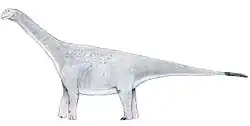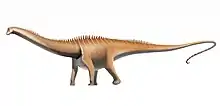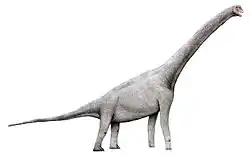| Opisthocoelicaudiines Temporal range: Late Cretaceous, | |
|---|---|
 | |
| Opisthocoelicaudia skeleton restoration in Museum of Evolution of Polish Academy of Sciences in Warsaw | |
| Scientific classification | |
| Domain: | Eukaryota |
| Kingdom: | Animalia |
| Phylum: | Chordata |
| Clade: | Dinosauria |
| Clade: | Saurischia |
| Clade: | †Sauropodomorpha |
| Clade: | †Sauropoda |
| Clade: | †Macronaria |
| Clade: | †Titanosauria |
| Family: | †Saltasauridae |
| Subfamily: | †Opisthocoelicaudiinae McIntosh, 1990 |
| Genera[1] | |
| Synonyms | |
| |
Opisthocoelicaudiinae is a subfamily of titanosaurian dinosaurs from the Late Cretaceous. It was named by John McIntosh in 1990. Opisthocoelicaudiines are known from Mongolia, Argentina, and the United States. Two genera were assigned to Opisthocoelicaudiinae by Gonzalez et al. (2009): Alamosaurus and Opisthocoelicaudia (the type genus),[4] a conclusion also found by Díez Díaz et al. (2018).[1] The hands of opisthocoelicaudiines lacked wrist bones and phalanges.[5]
It was suggested by Averianov and Lopatin in 2022 that Opisthocoelicaudia was not in fact closely related to Saltasaurus, and instead to Nemegtosaurus and Quaesitosaurus, which are both also Laurasian, as well as isolated teeth from the Turonian of Uzbekistan and the Santonian of Kazakhstan. Suggesting a more distant relationship to Saltasaurus, Averianiov and Lopatin suggested using the clade name Opisthocoelicaudiidae for the group, limiting Saltasauridae to Gondwanan taxa.[3]
Opisthocoelicaudiinae in a cladogram after Navarro et al., 2022:[6]
| Saltasauridae |
| ||||||||||||||||||||||||||||||||||||||||||||||||||||||
References
- 1 2 Díez Díaz, V.; Garcia, G.; Pereda-Suberbiola, X.; Jentgen-Ceschino, B.; Stein, K.; Godefroit, P.; Valentin, X. (2018). "The titanosaurian dinosaur Atsinganosaurus velauciensis (Sauropoda) from the Upper Cretaceous of southern France: New material, phylogenetic affinities, and palaeobiogeographical implications". Cretaceous Research. 91: 429–456. doi:10.1016/j.cretres.2018.06.015. S2CID 134977876.
- ↑ Villa, B.; Sellés, A.; Moreno-Azanza, M.; Razzolini, N.L.; Gil-Delgado, A.; Canudo, J.I.; Galobart, À (2022). "A titanosaurian sauropod with Gondwanan affinities in the latest Cretaceous of Europe". Nature Ecology & Evolution. 92 (3): 288–296. doi:10.1038/s41559-021-01651-5. PMID 35132183. S2CID 246650381.
- 1 2 3 Averianov, A.O.; Lopatin, A.V. (2022). "New Data on Late Cretaceous Sauropods from the Bostobe Formation of the Northeastern Aral Sea Region (Kazakhstan)". Doklady Earth Sciences. 503: 97–99. doi:10.1134/S1028334X22030047. S2CID 248378228.
- ↑ González Riga, Bernardo J.; Previtera, Elena; Pirrone, Cecilia A. (2009). "Malarguesaurus florenciae gen. et sp. nov., a new titanosauriform (Dinosauria, Sauropoda) from the Upper Cretaceous of Mendoza, Argentina". Cretaceous Research. 30 (1): 135–148. doi:10.1016/j.cretres.2008.06.006.
- ↑ Tidwell, Virginia; Carpenter, Kenneth (2005). Thunder-Lizards: The Sauropodomorph Dinosaurs. Bloomington, Indiana: Indiana University Press. p. 339. ISBN 0-253-34542-1. Retrieved April 6, 2010.
- ↑ Navarro, Bruno A.; Ghilardi, Aline M.; Aureliano, Tito; Díaz, Verónica Díez; Bandeira, Kamila L. N.; Cattaruzzi, André G. S.; Iori, Fabiano V.; Martine, Ariel M.; Carvalho, Alberto B.; Anelli, Luiz E.; Fernandes, Marcelo A.; Zaher, Hussam (2022-09-15). "A new nanoid titanosaur (Dinosauria: Sauropoda) from the Upper Cretaceous of Brazil". Ameghiniana. 59 (5): 317–354. doi:10.5710/AMGH.25.08.2022.3477. ISSN 1851-8044. S2CID 251875979.










